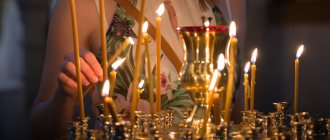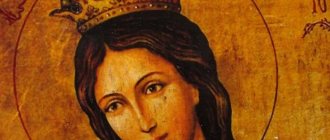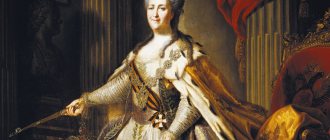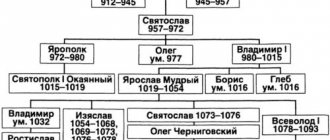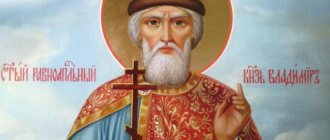What are bows
Bowing in church is the bowing of the body before God during prayer. They are usually performed after making the sign of the cross . During worship, a person bows many times.
Bows happen:
- Belt . A person bends at the waist while bowing from the waist, without bending his knees, touching the floor with his hand. Then he straightens his back. Otherwise called “small”.
- Terrestrial . They are also called “great”. When bowing to the ground, a person falls to his knees, touching his forehead to the floor. Then he gets up and straightens up.
There are different times for making prostrations and bows. On Sundays and church holidays, only bows from the waist are performed; high bows are prohibited. And during Great Lent, the most prostrations are performed, especially during the reading of the prayer of St. Ephraim the Syrian. During the period from Easter to Pentecost one cannot make great bows.
While reading the Six Psalms, it is forbidden to make even small bows; you can only cross yourself. When blessing the priest, you just need to bow your head, but not bow. When blessing with a cross, you must make the sign of the cross and make a small bow.
About bowing at every divine service[*]
The following signs of the cross without bowing, signs of the cross with bows from the waist, and signs of the cross with bows to the ground should be performed:
- at the initial exclamation of each service - 3 bows from the waist;
- on every Trisagion; “Come, let us worship...”; “Alleluia, alleluia, alleluia, glory to Thee, O God,” - 3 bows;
- exceptions: a) in the first part of Matins, before the Six Psalms, only the signs of the cross without bows are performed; b) on Alleluia (three times), during kathismas on Sundays and holidays, bows are left;
- on “Our Father...” (at the beginning) - bow;
- at the end of “It is worthy to eat...” (or Zadostoynik) - bow;
- when singing, reading troparions, kontakions, stichera, when the words express worship, one must bow;
- at each petition, after all the litanies, there is a bow;
- at every priestly exclamation there is a bow.
What do bows mean?
We bow during prayer, showing our reverence for the Creator. The body is not separated from the soul. Therefore, by bowing, a person expresses his humility and obedience. Bowing with soul and spirit before God, a person does the same with his body. Pride does not like bowing , the holy fathers said.
But on Sundays and holidays, parishioners should not bow to the ground, but stand upright in prayer, personifying the future eternal life. After the resurrection of the dead, believers will be sons of God and not slaves. Saint Basil the Great spoke about this .
Saint Anthony Khrapovitsky said that prostration represents the fall and rise of the human soul. When we fall to our knees, it shows the fall, humility. And when we then get up, it means rebellion, repentance , correction. Therefore, in church it is not customary to kneel for a long time; this is not an Orthodox custom. You have to fall to your knees and then get up.
Priest Andrei Lobashinsky says the same thing: sin brings a person to his knees, but repentance then restores him. God forgives him and makes him His son. This characterizes the spiritual freedom of a person.
In addition to these bows, there are also the following:
When shouting “Peace to all” or “Grace of our Lord Jesus Christ...”, when the priest blesses the people, bow your head, without the sign of the cross;
- when leaving without the Cross - bow your head, without the sign of the cross;
- when reading the Gospel - stand with your head bowed;
- when censing - respond to the censer with a bow, without the sign of the cross;
- when shouting “Bow your heads to the Lord,” bow your head;
- when leaving with the Cross - bow with the sign of the cross;
- when overshadowing those praying with the Cross, Gospel, icon or Chalice - bow with the sign of the cross;
- when overshadowing those praying with candles or with a hand - a bow without the sign of the cross.
Note:
[*] The rules about prostrations do not apply to Sundays. Read more: On the inadmissibility of prostrations on Sundays.
The text is based on the publication: Patriarchal Orthodox Calendar. Instructions of the Holy Fathers on prayer. 2008. Author-compiler E.Yu. Head Publishing Council of the Russian Orthodox Church, 2007. February 5–9.
How to bow correctly
Bows must be made correctly, without disturbing others or getting injured. It is worth remembering the saying: “make a fool pray to God...” When making bows from the waist, one must be wary of the possibility of stretching your back. With good sports training, you need to touch the floor with the fingers of your right hand. But if you have back pain, you can just bow a little. If there are a lot of people in the temple, quite crowded, then there is no need to be zealous and hit your head in the back of the person in front. You can simply bow your head without disturbing anyone.
When bowing to the ground, there is a chance of getting a head injury by hitting the floor hard. Here you should act wisely, bow, lightly touching your head to the floor. There is also a chance of damaging your palms, so you need to land on your bent knuckles. It is advisable to place a rug on the floor.
PORTAL CONTACTS
A few days ago we made the Great Entry. I have the Chalice in my hands, the deacon holds the paten. The choir sings touching chants, the parishioners reverently look at our procession. Some of the parishioners kneel down. Others feel awkward because they don't know how to behave. Someone also kneels, someone takes a bent position. Others simply, confused, look around - how to behave correctly?..
I say the prescribed prayers, enter the altar and think: how poorly our parishioners know the Rules of Conduct in the Church. The evil one helpfully throws out thoughts on this topic. I try to drive them away by concentrating entirely on prayer. But I promise myself to think about it in my spare time and write an essay about it. This essay is in front of you.
So, prayer gestures. At what time should a parishioner make the sign of the cross (that is, be baptized), and at what time should he bow? This is what we are talking about today.
The best advice that can be given to a person who is completely unfamiliar with the Rules of Divine Services and the rules of conduct during divine services is to watch how the priest and deacon behave. They cross themselves and bow – and so should the parishioners. They kneel - and the congregation needs to kneel. Even one observation of what and how the clergy do will, in a short time, allow one to assimilate the culture of behavior during worship and answer many questions. It’s strange, but even experienced parishioners sometimes don’t know how to behave correctly during worship. This suggests that parishioners do not look and do not think about what and how the clergy do. I mean what and how they do it in the service. Because in life, parishioners watch their priests very closely - what car he drives, how his wife and children are dressed, and much more.
But we should be attentive to what and how the priest does not in his worldly life - only God is the judge of every person, but during divine services, because here the priest is not an ordinary person, but a servant of God.
Bows
There are three types of bows:
1. A simple bow of the head;
2. Waist bow: we bow at the waist. If we follow strict rules, then during a bow we must lean forward so much that our fingers touch the floor.
3. Prostration: We kneel down and bow our heads to the ground. Then we get up.
In accordance with the rules of the Church Charter, during worship, all three types of bows are used in appropriate cases. At what time - which ones, we will now tell you:
Bowing your head
A brief bow of the head is never accompanied by the sign of the cross; we simply bow our heads or slightly bow our body:
A. To the words of the priest Peace to all; The blessing of the Lord is upon you, through grace and love for mankind...; The grace of our Lord Jesus Christ and the love of God and the Father and the communion of the Holy Spirit be with you all.
B. To the words of church hymns: let us fall down and worship.
B. Whenever a priest blesses not with the Cross, but with his hand. When the priest blesses with the Cross (for example, after the Liturgy, on vacation, or at other moments, you should cross yourself and then make a bow from the waist)
D. Whenever a priest (or bishop) blesses with candles.
D. Whenever you are incense. By censing, the deacon (or priest) expresses respect to the person as the image of God. In response, we bow to the deacon (or priest). The exception is on the night of Holy Easter. Then the priest censes with the Cross in his hand and greets everyone with the cry of Christ is Risen. Here you need to first cross yourself and then bow.
Prolonged bowing of the head
When the deacon cries: Bow your heads to the Lord, and let us bow our heads to the Lord. At these words, you should bow your head and stand there the entire time the prayer is being read.
E. We bow our heads during the Great Entrance, when the procession of clergy stops at the pulpit.
G. While reading the Holy Gospel.
Bow from the waist
We always make the sign of the cross before bowing from the waist!
Having made the sign of the cross, we bow in bow:
A. After each petition of the deacon’s litany, at the time when the choir sings, Lord, have mercy or Grant, Lord.
B. After each exclamation of the priest, with which he concludes the litany.
B. Always when singing in chorus: Glory to the Father and the Son and the Holy Spirit.
D. For each: Holy God, Holy Mighty, Holy Immortal, have mercy on us (during the Liturgy).
D. After singing the Most Honest Cherub.
E. When reading akathists - on each kontakion and ikos; when reading the canons at the evening service - before each troparion.
G. Before the beginning and after the end of the reading of the Gospel, while the choir is singing: Glory to Thee, Lord, Glory to Thee.
H. Before the beginning of the singing of the Creed (at the Liturgy).
I. Before the beginning of the reading of the Apostle (at the Liturgy).
K. Whenever the priest blesses with the Cross (for example, after the Liturgy, at dismissal, during the singing of the Many Years, and on other occasions).
L. Whenever they bless the Chalice, the Cross, the Holy Gospel and the icon.
M. At the beginning of the singing of the prayer Our Father.
N. When passing by the royal gates inside the temple, we must also cross ourselves and bow.
Prostrations
Prostrations are cancelled:
A. From Easter to the Feast of the Holy Trinity;
B. From the Feast of the Nativity of Christ to the Feast of Epiphany (on Christmastide);
G. On the days of the twelve (twelve great) holidays;
D. On Sundays. However, here it is important to clarify the following: although since ancient times Sunday has enjoyed special respect, nevertheless, some Christians, due to their reverent attitude towards the shrine of the Body and Blood of Christ, wanted to bow to the ground in front of the shrine on these days. Thus, the custom of allowing two prostrations to the ground even on Sunday became established:
1) after the words of the priest: Translating by Your Holy Spirit;
2) and then, when the Cup with the Body and Blood of Christ is brought out to all believers with the words: Approach with the fear of God and faith.
It is at these two moments that bowing to the ground, even on Sunday, is blessed. At other moments, it is not blessed (except for bowing before the Cross and the Shroud, if they are located in the middle of the temple).
The first of the moments - the end of the consecration of the Holy Gifts - is not easy to track if the royal doors are closed and through them you cannot see how the clergy bow to the ground. In this case, you can bow to the ground while the priest exclaims: Holy to holies.
If the day is not Sunday, then one more must be added to these two prostrations during the Liturgy. This bow is made when the Chalice is shown to the believers for the last time. And this happens after Communion. When everyone has received communion, the priest brings the Chalice into the altar, reverently immerses particles taken from the prosphora into it, and quietly reads the prescribed prayers. After this, the priest turns with the Cup to the believers and proclaims: Always, now and ever, and unto ages of ages! At this time, it is also necessary to bow to the ground. If the day is Sunday, then you need to sign yourself with the sign of the cross and make a bow from the waist.
E. Prostrations to the ground are also canceled until the evening for the person who has received communion. But with the beginning of the evening service, a new liturgical day begins, so starting in the evening, even a communicant can bow to the ground.
We talked about when prostrations are canceled. What can we say about when, on the contrary, they are placed?
It is impossible to list all the cases where prostrations are required; there are many of them. What is important is this: whenever worshipers are called to prostrate, this bow is done by the clergy themselves. There are many such cases during Lent. Watch the priests - and you won’t be mistaken.
Kneeling
I’ll say right away that in the Orthodox tradition it is not customary to pray on your knees. Other priests don’t know this either. You look, sometimes the Eucharistic canon begins - and everyone in the altar kneels and remains in that position. Friends: praying on your knees is a custom of the Catholic Church. In Orthodoxy they kneel for a short time:
A. During the transfer of a shrine (for example, at the Liturgy of the Presanctified Gifts)
B. Listen to kneeling prayers once a year on Trinity Day;
B. They kneel during prayer (for example, after a prayer service), when the deacon (or priest) called for this: Kneel, let us pray.
G. You can kneel down when a particularly revered shrine is carried past, for example the Miraculous Icon or relics. But people don’t just kneel in church and, moreover, they don’t remain in that position for a long time.
We sign ourselves with the sign of the cross, but do not bow
A. During the reading, six psalms. It is read during Matins, which can be served in the morning or in the evening. Also, the Six Psalms are always performed during the all-night vigil, that is, on Saturday evenings and on the eve of holidays.
The Six Psalms consists of six psalms. In the middle, after three psalms, the reader proclaims:
Alleluia, Alleluia, Alleluia, glory to You, O God. Alleluia, Alleluia, Alleluia, glory to You, O God. Alleluia, Alleluia, Alleluia, glory to You, O God. Lord, have mercy, Lord, have mercy, Lord, have mercy. Glory to the Father and the Son and the Holy Spirit, now and ever, and unto ages of ages. Amen.
The Six Psalms are performed in deep silence and reverence. These six selected psalms speak of humanity's expectation of the Messiah - the Savior. Silence here denotes the state in which ancient humanity was on the eve of the Coming of Christ: concentrated expectation of deliverance from sin.
B. At the beginning of the singing of the Creed;
D. At the beginning of the reading of the Apostle, the Gospel (at the Liturgy, at the All-Night Vigil);
D. When reading the proverbs begins (at the all-night vigil before a major holiday)
E. When the priest pronounces the words by the Power of the Honest and Life-Giving Cross (these words are found in some prayers).
On the night of Holy Easter, the priest censes the believers and greets them with the cry: Christ is Risen! Believers answer: Truly He is Risen! They sign themselves with the sign of the cross and bow in response.
Orthodox encyclopedia "ABC of Faith"
When is the right time to bow?
During the Divine Liturgy, it is customary to bow during the Small Entrance, the Great Entrance, at the Eucharistic Canon with the exclamation of the priest “We thank the Lord,” during the Transubstantiation of the Holy Gifts (three bows), during the removal of the Chalice, with the exclamation: “always, now and ever.” and forever and ever" and at the dismissal. You can also bow at any time when your soul requires it.
After receiving the Holy Mysteries, it is not customary to bow down for the sake of reverence for Christ who has entered the soul. Three bows must be made at the entrance to the temple, as well as before leaving it. Before venerating the icon, you must bow two times before and one after. When blessing a priest with the Gospel or the cross, one must make the sign of the cross and bow. When shouting: “peace to all,” and also: “bow your heads to the Lord,” you must bow without making the sign of the cross.
You must make three prostrations in front of the Shroud: two before and one after veneration. The same must be done when applying to holy relics.
Conclusion
But it is necessary to remember that Orthodoxy is not a set of laws . Within a person there is always his own charter, which sometimes does not coincide with the established rules. Therefore, if a person’s heart asks to kneel before God, one can bow even when this is prohibited by the statute.
And you especially shouldn’t rudely pull back a person who prostrates at an inappropriate time, thereby disturbing the person’s reverent and prayerful mood. Let it be better for the charter to be trampled upon than for the prayerful mood to be destroyed. In this case, one should not mindlessly follow the letter of the law, like the Pharisees and scribes. Everyone knows how this blind observance of the law ended - with the crucifixion of Christ.
prot. Andrey Tkachev on bowing in prayer
About bowing during the all-night vigil
At the beginning of the Six Psalms, with the triple “Glory to God in the highest” - 3 signs of the cross (without bowing!);
- in the middle of the six psalms, with three times “Alleluia” - 3 signs of the cross (without bowing!);
- during the polyeleos, during the first and last magnification (which are sung by the clergy in the middle of the temple) - after bowing to the ground;
- to “Glory to Thee, Lord...” before reading the Gospel and after reading - by bowing;
- before kissing the holy Gospel or holy icon - 2 bows;
- after kissing - 1 bow;
- at the canon, with all the choruses of all nine songs - bow;
- at “My soul magnifies the Lord”, at the end of each “Most Honest” - a bow;
- to “Glory to Thee, who showed us the light” before the great doxology - a bow;
- after the great doxology on the Trisagion - 3 bows.
In what cases is kneeling prohibited?
Unfortunately, the church charter does not clearly identify those cases when believers are supposed to kneel. On the other hand, it says when prostrations are inappropriate. We are talking about Sunday services, services in honor of major church holidays, on the day of the Nativity of Jesus Christ, His Baptism, and Resurrection. It is also forbidden to kneel during the sacrament of communion (this is, in particular, stated in the Ecumenical Councils).
In Japan everyone bows
“They all bow all the time” is one of those facts about Japan that surprisingly doesn’t require refutation, as stereotypes often do.
Yes . In a store, at an airport, in a hotel, at work, at school, on posters, in advertising, in restaurants.
The Japanese bow everywhere.
The problem, however, appears for us Europeans, regardless of whether we go to Japan as tourists or move here for work.
On the one hand, we would like to try to understand at least the basics.
“How can you avoid violating business etiquette or otherwise offending the Japanese?”
And for those who go to Japan to work, there is an understandable desire to stand out at least a little less.
On the other hand, some of us find it difficult to overcome the cultural barrier.
“Bowing, and even in a public place? This is not a karate class or a Kurosawa film!” - Many people think that we will look stupid.
The last problem is easy to deal with.
Remember: you will be surrounded by a different culture. And as the Americans say, “When in Rome, do as the Romans do . We can bow calmly and no one will look at us askance.
Man is a creature that adapts quite quickly. Before we even notice, we will automatically begin to imitate the Japanese around us.
A few days in Japan and we will calmly respond with a nod of the head or a slight bow to the obligatory morning “Ohayo Gozaimasu” of hotel or ryokan workers. This will also become something natural for us.
Well, what about the peculiarities of bows? When should you bow? Are there any mandatory nuances that need to be kept in mind? Should we bow to the floor every time we see the boss or salesperson of 7/11 or Family Mart.*
One way or another, I want to feel confident functioning in Japanese society.
There are a lot of questions, so let's figure it out.
*No no need.
Television is no exception. Gunji Kyoko and Oha4 hosts © Nippon TV
LiveInternetLiveInternet
Bows:
They are universal gestures of etiquette; they accompany greetings, congratulations, requests, etc. and may vary depending on the situation. Bows can be performed in three positions: standing, sitting, Japanese, and European. Also, most bows have a female and a male form. When meeting, those lower in age and position bow first and with a more polite bow.
According to the degree of politeness, bows can be divided into three groups:
1. standard polite bow (rei, ojigi) with a body tilt of about 30°; 2. everyday standard or lightweight (esyaku) with an inclination of up to 15°; 3. ceremonial or respectful (saikeirei) with an inclination from 45° to 90°.
Types of bows:
—Standing.
Bows of this kind are most common in everyday and business communication. The bow itself is performed from the following starting position: those bowing stand opposite each other at a distance of three steps and look into each other’s eyes. While bowing, your back must be kept straight and your legs must be together. Men's hands lie freely at the seams, socks are slightly apart. Women fold their arms in front of them, and their socks may point slightly inward. Those bowing spend about two seconds in a bowed state, after which they slowly straighten up and look at each other again. The most typical situation with a bow is a greeting.
- sitting in Japanese.
Such bows are performed exclusively in rooms with Japanese interiors and are performed from an official sitting position (seiza, hiza o soro-ete suwaru): sitting, resting on your heels and knees, keeping your back straight. Men's hands rest loosely on their hips, women fold them in front of them, and their hips are closed. - sitting in a European style.
Typically performed in European room settings and in formal situations. In personal communication, they are permissible only in relation to a junior or subordinate person. They are performed in the same way as bows while standing, hands are held as when bowing while sitting in Japanese.
bows from right to left
Urgent Requests:
Usually accompanied by ceremonial bows with the words: “Kono to: ri onegai shimasu” (“I beg you very much!”).
Requests:
The hands are folded in front of the face and the person asking bends in a slight bow. As a rule, they are accompanied by the words: “Kono to: ri desu” (polite form), “Issho: no onegai” (children’s or youth version), “Kono to: ri” (male version).
Light gratitude (or apology):
This everyday gesture is performed with the help of a light bow, silently or with the words: “Do: mo” or “Sumimasen”, i.e. (“Thank you” and “Sorry”) respectively.
Polite thanks (or apology):
Both are expressed through standard or everyday bows with the words “Do: mo sumimasen” (“Excuse me, please”) or “Arigato: gozaimasu” (“Thank you...”).
Deep gratitude (or apology):
Expressed by standard or ceremonial bows with the words: “Mo: shivake arimasen” (“Very guilty”) or “Orei no kotoba mo gozaimasen” (“There are no words to express my gratitude”). The deepest gratitude or apology can be expressed by ceremoniously bowing while sitting in Japanese: “Te o tsuite ayamaru” (literally: “asking for forgiveness by touching the ground with hands”). PS I was shocked when a Japanese woman demonstrated types of bows on TV today. Ooh!
This is beyond the capabilities of a European... The presenter was only able to bend over 5 degrees. And she was like a taut string!
The presenter was only able to bend over 5 degrees. And she was like a taut string!
Source: www.thegazette-forum.com
